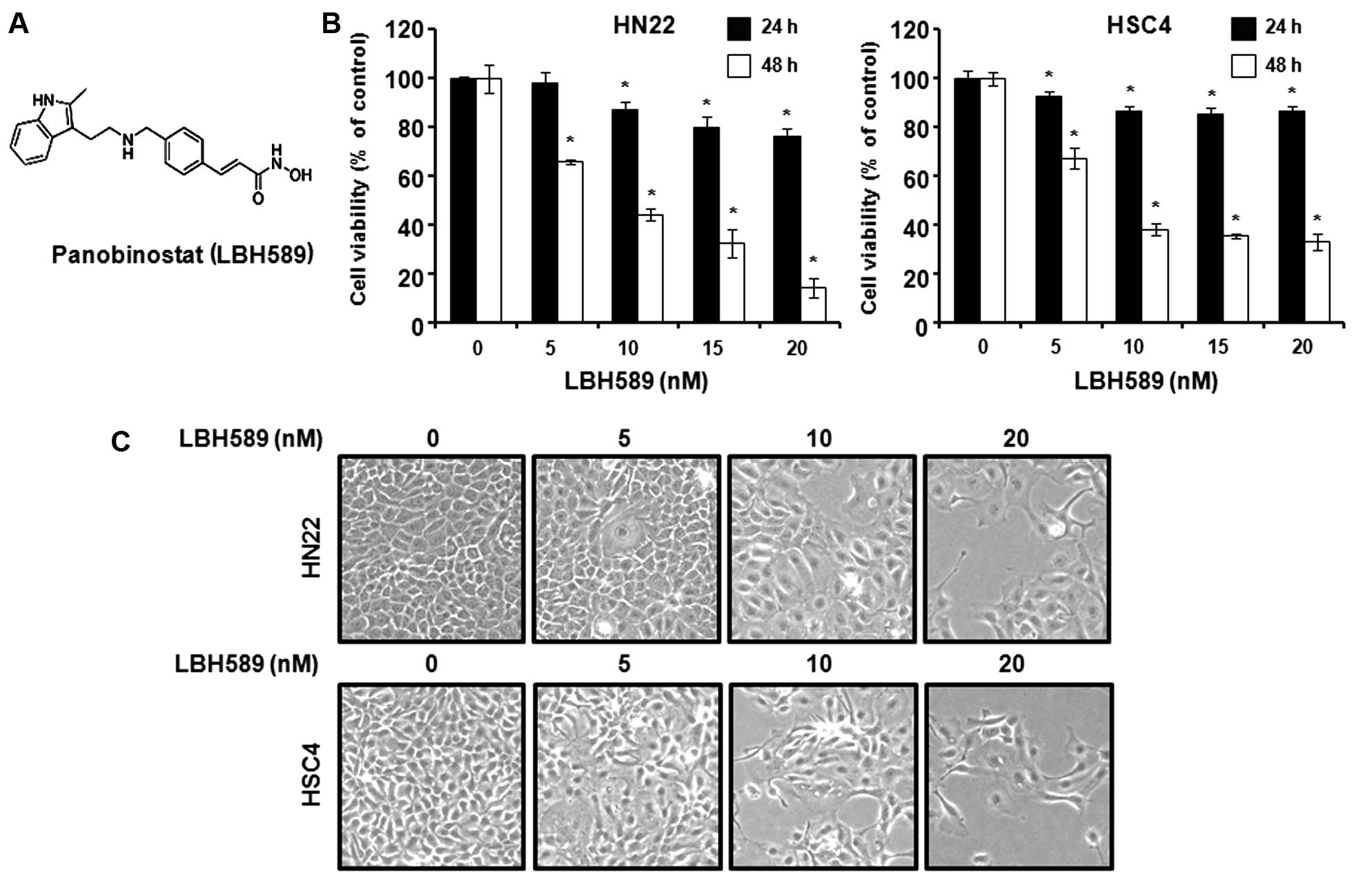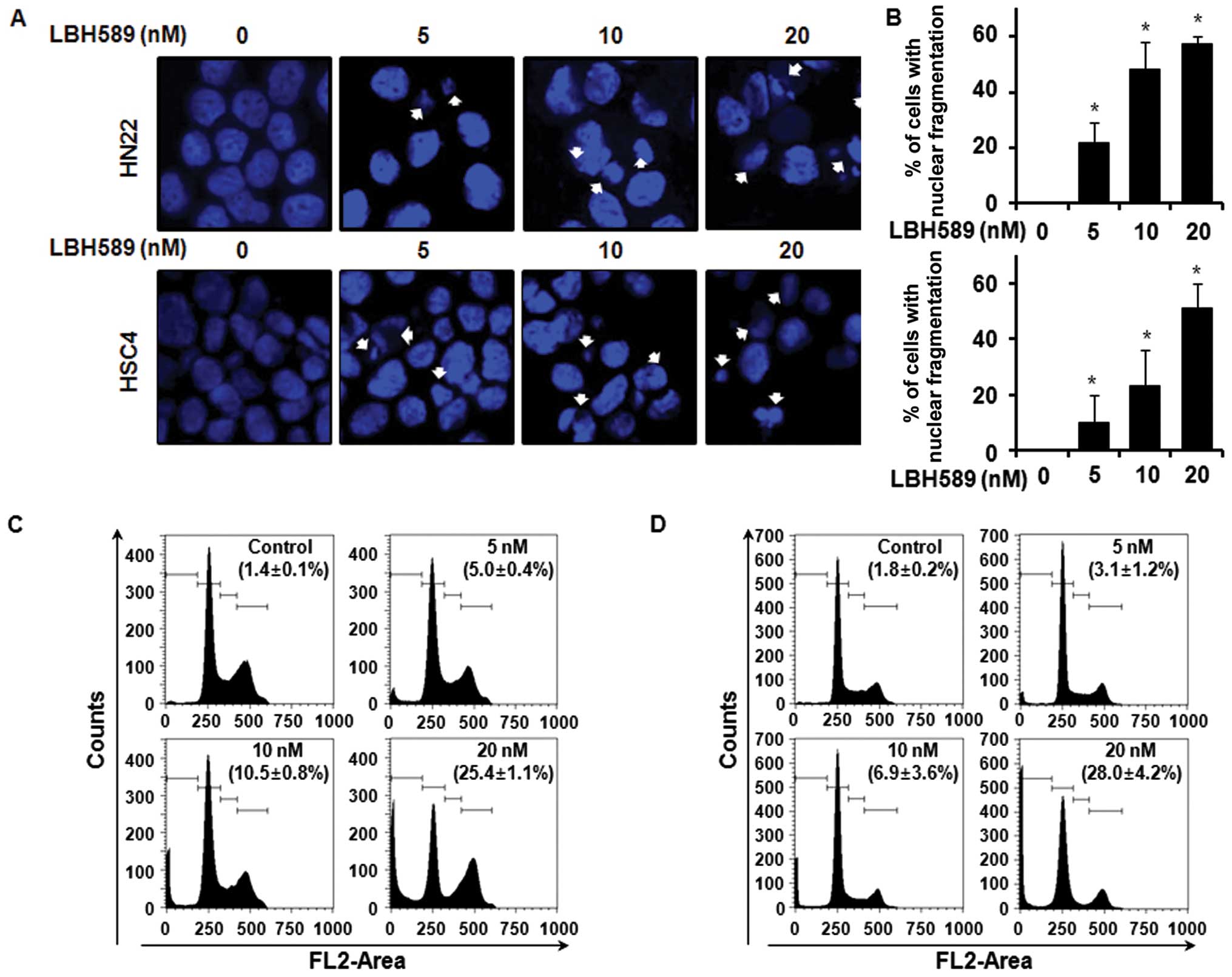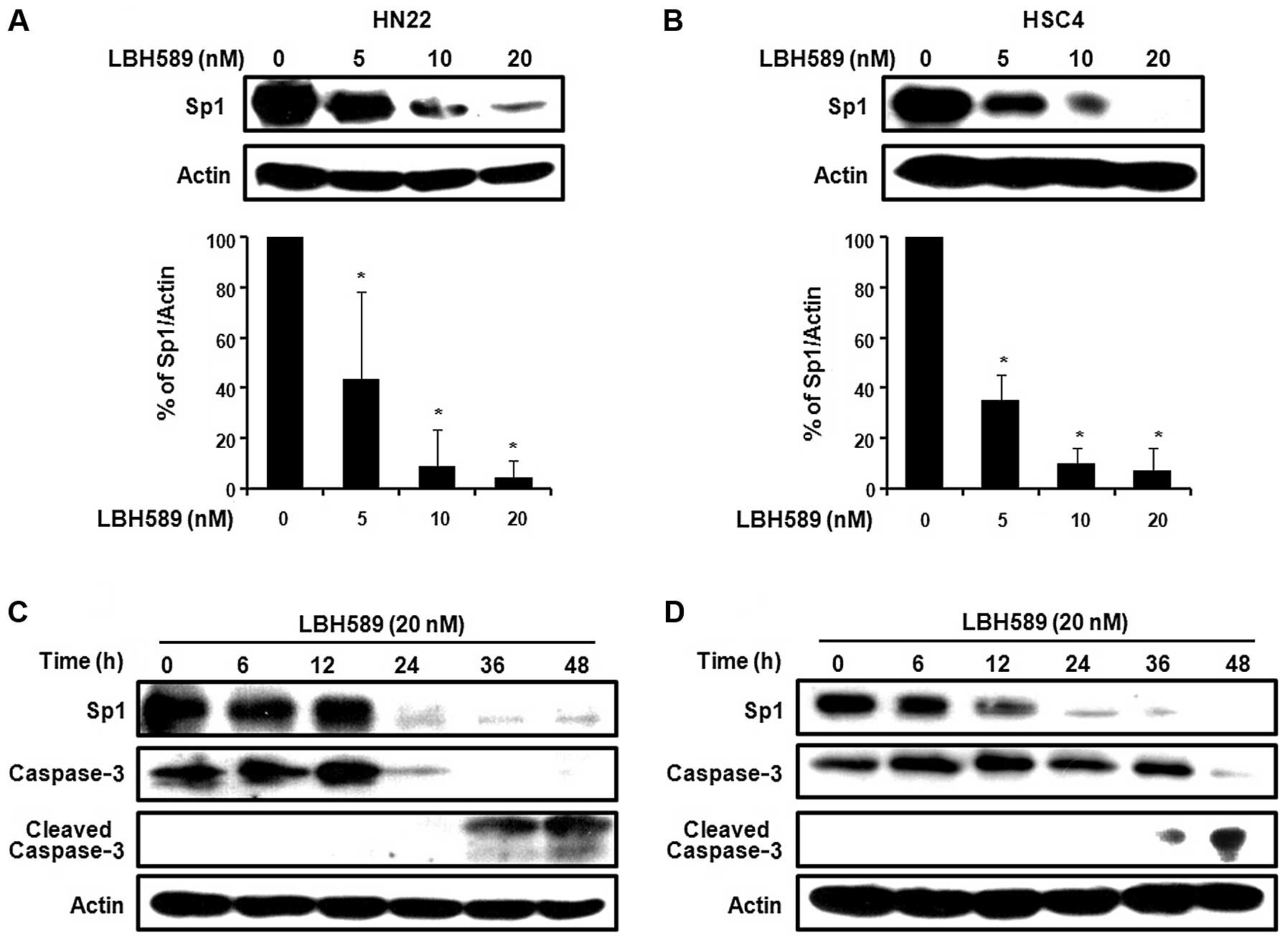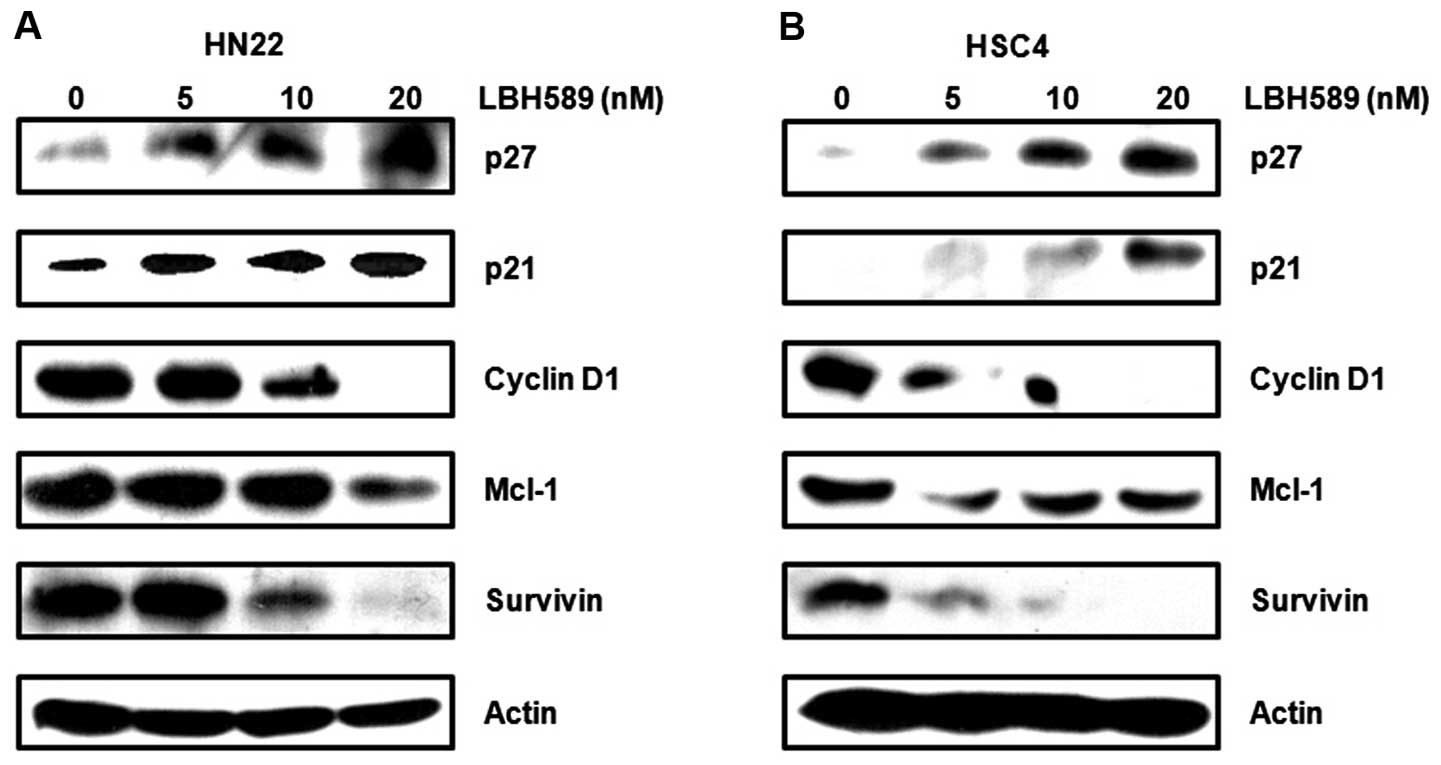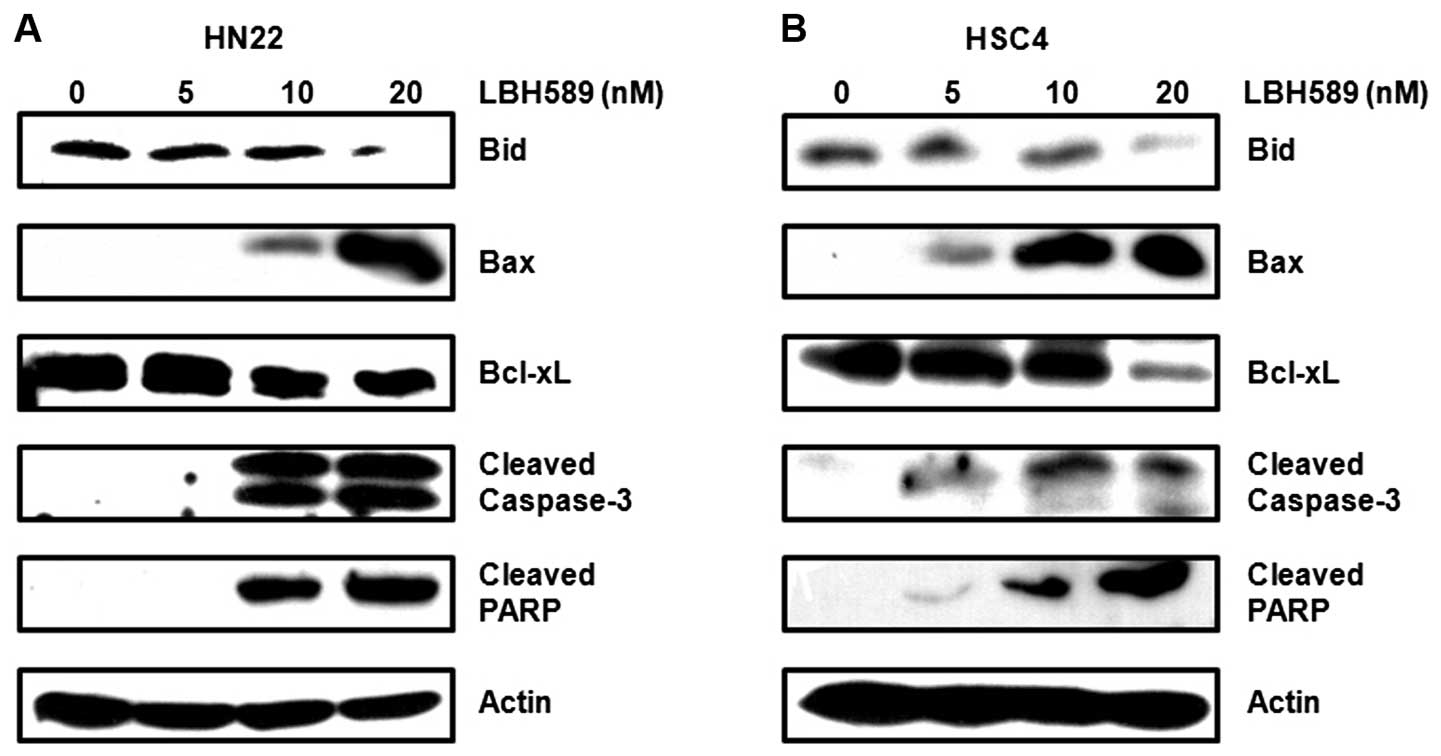The HDAC inhibitor, panobinostat, induces apoptosis by suppressing the expresssion of specificity protein 1 in oral squamous cell carcinoma
- Authors:
- Published online on: July 18, 2013 https://doi.org/10.3892/ijmm.2013.1451
- Pages: 860-866
Abstract
Introduction
Oral squamous cell carcinoma (OSCC) is an aggressive epithelial malignancy with a poor prognosis despite advances in diagnosis and treatment (1). The most common risk factor for OSCC is tobacco, alcohol, ultraviolet light and oral lesions (2,3). Although surgery is effective, the incidence of this type of cancer is increasing (4). Accordingly, the development of optimal treatment or therapeutic strategies for OSCC, as well as novel therapeutic regimens to prevent and treat OSCC is mandatory.
Natural products, potential sources of new drugs, have been applied in the field of medicine, pharmacy and biology for the past several decades (5). Histone deacetylase (HDAC) inhibitors, a novel class of chemotherapeutic drug, have shown potent anticancer activities in preclinical studies (6). HDAC inhibitors induce the rapid histone hyperacetylation of nucleosomal histones and chromatin remodeling, leading to changes in the expression of genes that control growth, differentiation and survival (7,8). Specifically, HDAC inhibitors have been linked to several downstream effects in tumor cell lines, resulting in cell cycle arrest and the induction of apoptosis (9–11). A wide range of structurally diverse HDAC inhibitors has been purified from natural products and synthetically produced. Therefore, several clinical trials have been initiated.
Panobinostat (LBH589) is a novel HDAC inhibitor that blocks multiple cancer-related pathways and reverse epigenetic events implicated in cancer progression (12). HDACs can be subdivided into two groups: zinc-dependent HDACs (class I, class II a/b and class IV) and zinc-independent HDACs (class III) (13). LBH589 is characterized as a pan-deacetylase (pan-DAC) inhibitor, with activity against class I, II and IV HDACs (12). LBH589 exerts inhibitory effects at low nanomolar concentrations across a wide range of hematological malignancies, such as lymphoma, acute myeloid leukemia and multiple myeloma (14–16). However, its effects on oral cancer and the mechanisms behind LBH589-induced apoptosis remain poorly understood.
In the present study, we examined the effects of LBH589 on two OSCC cell lines, HN22 and HSC4. We demonstrate that LBH589 inhibits cell growth and induces apoptosis in the HN22 and HSC4 cells. The results from the present study provide experimental evidence to support the hypothesis that LBH589 decreases specificity protein 1 (Sp1) expression and inhibits OSCC cell viability by inducing cell cycle arrest and activating apoptotic pathways. Our results also provide evidence for the chemotherapeutic efficacy of LBH589 in the treatment of OSCC.
Materials and methods
Materials
HN22 and HSC4 cells are human oral squamous cancer cell lines. HN22 cells were provided by Dankook University (Cheonan, Korea) and HSC4 cells were provided by Hokkaido University (Hokkaido, Japan). HN22 and HSC4 cells were cultured in HyClone Dulbecco’s modified Eagle’s medium (DMEM) (Thermo Scientific, Logan, UT, USA) containing 10% heat-inactivated fetal bovine serum and 100 U/ml each of penicillin and streptomycin (Thermo Scientific) at 37°C with 5% CO2 in a humidified atmosphere. LBH589 was purchased from SelleckBio (Houston, TX, USA).
3-(4,5-Dimethylthiazol-2-yl)-5-(3-carboxymethoxyphenyl)-2-(4-sulfophenyl)-2H-tetrazolium (MTS) assay
The effect of LBH589 on cell viability was estimated using the CellTiter 96® AQueous One Solution Cell Proliferation Assay kit (Promega, Madison, WI, USA) according to the manufacturer’s instructions for MTS assay. The HN22 and HSC4 cells were seeded in 96-well plates for 24 h and treated with various concentrations of LBH589 for 24 and 48 h. The absorbance was measured at 490 nm using a GloMax-Multi Microplate Multimode Reader (Promega). The data were expressed as the percentage of cell viability compared with the control.
DAPI staining
The number of cells undergoing apoptosis following treatment with LBH589 was quantified using DAPI staining. The cells with nuclear condensation and fragmentation were determined using nucleic acid stained with 4′-6-diamidino-2-phenylindole (DAPI) (Sigma-Aldrich). After 48 h of post-treatment with different doses of LBH589 (5, 10 and 20 nM), the HN22 and HSC4 cells were harvested and fixed in 100% methanol at room temperature for 20 min. The cells were seeded on slides, stained with DAPI (2 mg/ml) and then monitored by a FluoView confocal laser microscope (Fluoview FV10i, Olympus Corp., Tokyo, Japan).
Western blot analysis
Following the treatment of the cells with LBH589, the cells were washed twice with ice-cold phosphate buffered saline (PBS) and harvested in an ice-cold PRO-PREP™ protein extraction solution (Intron Biotechnology, Seoul, Korea) containing a protease inhibitor. Protein concentrations were measured using the Bradford protein assay. Protein samples were separated on SDS-PAGE gels and transferred onto an Immobilon-P PVDF transfer membrane (Millipore, Billerica, MA, USA) using a semi-dry blotting apparatus. Western blot analysis was performed using ECL western blotting detection reagent according to the manufacturer’s instructions (Thermo Scientific, Rockford, IL, USA).
Propidium iodide (PI) staining
Following the treatment of the cells with LBH589, the detached cells were collected separately and the adherent cells were dissociated by trypsin-EDTA. The cells were washed with cold PBS and then pooled and centrifuged before being fixed in 70% ethanol overnight at −20°C. Before flow cytometry analysis, the cells were centrifuged and incubated for 30 min at 37°C in PBS to allow for the release of low-molecular weight DNA. Following centrifugation, the cell pellets were resuspended and treated with 150 mg/ml RNase A and 20 mg/ml PI using a MACSQuant® analyzer (Miltenyi Biotec GmbH, Bergisch Gladbach, Germany).
Immunocytochemistry
The cells were seeded onto glass cover slips on 6-well tissue culture plates for 24 h and incubated with LBH589 for 48 h. The cells were fixed/permeabilized with cytotoxic solution for 30 min. For the analysis of the expression of Sp1 and caspase-3, the cells were blocked with 1% BSA and then incubated with monoclonal Sp1 and cleaved caspase-3 antibody at 4°C overnight. After washing with PBS, the cells were incubated with Alexa Fluor® 546 anti-mouse IgG and Alexa Fluor® 488 anti-rabbit IgG (1:1,000 dilution; Molecular Probes) in 1% BSA for 1 h and mounted with VECTSHIELD® mounting medium for fluorescence with DAPI (Vector Laboratories, Inc., Burlingame, CA, USA) onto the cells. The cells were visualized using a laser confocal microscope.
Statistical analysis
The statistical significance of the differences between groups was assessed using the Student’s t-test. The null hypothesis was rejected at a p-value <0.05.
Results
LBH589 inhibits cell viability and induces the apoptosis of human OSCC cells
The aim of this study was to investigate whether LBH589 exerts growth inhibitory effects on human OSCC cells. The structure of LBH589 is shown in Fig. 1A. To investigate the efficacy of LBH589 as an anticancer drug, the HN22 and HSC4 cells were treated with LBH589 and cell viability was determined by MTS assay. As shown in Fig. 1B, MTS assay was carried out following treatment with LBH589 at various concentrations (5, 10, 15 and 20 nM) for 24 h or 48 h. The cell viability graphs show that LBH589 reduced HN22 and HSC4 cell viability at 24 h and 48 h, in a concentration-dependent manner (p<0.05). The maximal decrease was observed at 48 h relative to 24 h. The morphological changes were observed under an optical microscope after 48 h; the apoptotic phenotype showed was a rounded cell, with cytoplasmic blebbing and irregularities in shape (Fig. 1C). These results indicate that LBH589 inhibits the growth of human OSCC cells.
LBH589 induces G1 phase cell cycle arrest and apoptosis in OSCC cells
Cancer cell growth can be suppressed by cell cycle arrest or the induction of apoptosis, or both (17). We carried out a confocal laser microscopic analysis of the LBH589-treated HN22 or HSC4 cells to demonstrate the apoptotic morphological changes using DAPI staining, which specifically stains the nuclei. The results revealed the presence of nuclear condensation and perinuclear apoptotic bodies upon LBH589 treatment at a concentration of 5, 10 and 20 nM for 48 h. The percentage of cells with nuclear fragmentation in the LBH589-treated group compared with the DMSO-treated group is shown in Fig. 2A and B. To determine whether the LBH589-mediated growth inhibition of HN22 or HSC4 cells was attributed to cell cycle arrest, the cell cycle distribution was analyzed by FACS analysis. As shown in Fig. 2C, in the HN22 cells, there was a significant increase in the number of sub-G1 cells: 5.0±0.4% in the presence of 5 nM of LBH589, 10.5±0.8% with 10 nM and 25.4±1.1% with 20 nM LBH589, compared with the untreated control cells. In the HSC4 cells, an increase in the number of sub-G1 cells was also observed: 3.1±1.2% at a concentration of 5 nM LBH589, 6.9±3.6% at 10 nM and 28.0±4.2% at 20 nM of LBH589 compared with the untreated control cells. The graph shows the quantification of the FACS data (Fig. 2D).
LBH589 suppresses Sp1 expression in OSCC cells
Sp1 plays an important role in oncogenesis. Therefore, if the expression level of Sp1 protein may be effectively modulated by a chemotherapeutic agent, then the agent may be a potent candidate for an anticancer drug by suppressing tumor progression. To determine whether Sp1 protein expression levels were reduced by LBH589, the HN22 and HSC4 cell lines were treated with various concentrations of LBH589 at 0, 5, 10 and 20 nM for 48 h. As shown in Fig. 3A and B, treatment with LBH589 induced a significant decrease in the protein expression levels of Sp1 in the HN22 and HSC4 cells in a dose-dependent manner. To further investigate the apoptotic effects of the downregulation of Sp1 by LBH589, the two OSCC cell lines, HN22 and HSC4, were treated with 20 nM LBH589 for different periods of time (0, 6, 12, 24, 36 and 48 h). The Sp1 levels significantly decreased as time progressed. LBH589 also induced the cleavage of caspase-3, thus inducing apoptosis (Fig. 3C and D). Consistent with these observations, the immunocytochemistry results also revealed a decreased level of Sp1 and an increased level of cleaved caspase-3 in a dose-dependent manner in the HN22 and HSC4 cell lines (Fig. 3E). Collectively, these results suggest that the downregulation of Sp1 by treatment with LBH589 leads to apoptotic cell death.
LBH589 modulates the regulator of cell cycle arrest and apoptosis in OSCC cells
Sp1 has been shown to regulate the expression of various gene products involved in cell cycle progression, growth and apoptosis, an important role in oncogenesis (18,19). To further support the association between LBH589 and Sp1-mediated apoptosis, we investigated Sp1 target proteins and apoptotic proteins. We found that the cell cycle arrest involved proteins, such as p27 and p21, which were significantly increased by LBH589, whereas cell proliferation and survival-related proteins, such as cyclin D1, myeloid cell leukemia-1 (Mcl-1) and survivin, were remarkably attenuated by LBH589 treatment in a dose-dependent manner (Fig. 4A and B). Furthermore, we investigated the expression of proteins involved in apoptosis regulation. As shown in Fig. 5A and B, the downregulation of Bid and Bcl-xL and the upregulation of Bax appeared to be involved in the apoptotic cell death induced by LBH589. In addition, the cleavage of caspase-3 and PARP was induced by LBH589 in a dose-dependent manner. These results indicate that the treatment of OSCC cells with LBH589 induces the downregulation of Sp1, resulting in growth arrest and the induction of apoptotic cell death.
Discussion
While the cellular responses of disparate chemotherapeutic agents seem to be many and varied, it now seems certain that a major mechanism of action of such agents is the induction of endogenous cell death pathways, inducing apoptosis and thereby eliminating tumor cells (20). The first pathway is the ligation of death receptors, such as Fas and tumor necrosis factor receptor (TNFR), inducing a cascade of protein-protein interactions mediated by caspases (21). The other pathway, stimulated by stress stimuli, such as growth factors and chemotherapeutic drugs, uses the mitochondria as a key component for the induction of cell death, resulting in the release of mitochondrial proteins and the activation of caspases (22).
The effectiveness of chemotherapeutic agents can be affected by alterations in apoptotic pathways, and this possibility is becoming an important factor in determining the most effective chemotherapeutic drugs for cancer treatment. HDAC inhibitors have appeared as promising chemotherapeutic agents by their ability to induce apoptosis and inhibit cell cycle progression (23–25). The antitumorigenic effects of HDAC inhibitors are notable due to the fact that their cytotoxicity is specific to cancer cells and not to normal cells or tissues. Compared with other anticancer drugs, HDAC inhibitors are well tolerated with a good toxicity profile (26). A number of studies have reported that LBH589 exerts antitumor effects on various cancer-derived cells, including epithelial ovarian, prostate and liver cancer cells, as well as hepatocellular carcinoma cells (27–30). Nevertheless, the anticancer activities of LBH589 on human OSCC cells are not yet fully understood. LBH589 triggers ER stress with the activation of caspase-12, the upregulation of phosphorylated JNK and the overexpression of CHOP, with the final activation of executioner caspase-3 (30).
In this study, we determined whether LBH589 is capable of inhibiting cell growth and decreasing Sp1 expression, thus inducing apoptosis in OSCC cells. We found that LBH589 inhibited cell growth and induced apoptosis in the HN22 and HSC4 cell lines. Moreover, the LBH589-induced apoptosis was associated with a decrease in Sp1 expression in the HN22 and HSC4 cells.
The ubiquitous transcription factor, Sp1, is overexpressed in various human cancer cell lines (31–35) and plays a role in the regulation of genes which are involved in many cellular processes (36). Sp1 has transcriptional activity on the promoters of genes involved in cell cycle progression, differentiation and oncogenesis (37). Several studies have demonstrated that HDAC inhibitors downregulate different Sp1 target proteins by inhibiting Sp1 activity (38,39). In this study, Sp1 expression was significantly decreased in the LBH589-treated cells. LBH589 also regulated apoptosis-related proteins, such as caspase-3. Treatment with LBH589 induced the cleavage of caspase-3, thus promoting apoptosis.
To further characterize the effects of LBH589 on Sp1, we analyzed the effects of LBH589 on p27, p21, cyclin D1, Mcl-1 and survivin, a Sp1 target protein, by western blot analysis (40–42). The results revealed that LBH589, as a HDAC inhibitor, also inhibited the level of Sp1 and regulated Sp1 target proteins, such as p27, p21, cyclin D1, Mcl-1 and survivin in a dose-dependent manner. Consistent with this, LBH589 reduced Bid and Bcl-xL expression and increased Bax expression. LBH589 also activated caspase-3 and PARP, suggesting that LBH589 regulated Sp1 and ultimately led to apoptotic cell death.
In conclusion, the present study demonstrates that LBH589 suppresses Sp1 expression, leading to the upregulation of p27 and p21 and the downregulation of cyclin D1, Mcl-1 and survivin and a subsequent decrease in cell viability through a caspase-3-dependent apoptotic signaling pathway in OSCC cells. The present study delineates, in part, the signaling pathways involved in the LBH589-induced decrease in the viability of OSCC cells.
Acknowledgements
This study was supported by the Basic Science Research program through the National Research Foundation Korea (NRF) funded by the Ministry of Education, Science and Technology (2011-0008463) and the Next-Generation BioGreen 21 Program (PJ008116062011), Rural Development Administration, Republic of Korea.
References
|
Forastiere A, Koch W, Trotti A and Sidransky D: Head and neck cancer. N Engl J Med. 345:1890–1900. 2001. View Article : Google Scholar | |
|
Mashberg A, Boffetta P, Winkelman R and Garfinkel L: Tobacco smoking, alcohol drinking, and cancer of the oral cavity and oropharynx among U.S. veterans. Cancer. 72:1369–1375. 1993. View Article : Google Scholar : PubMed/NCBI | |
|
Neville BW and Day TA: Oral cancer and precancerous lesions. CA Cancer J Clin. 52:195–215. 2002. View Article : Google Scholar : PubMed/NCBI | |
|
Liang XH, Lewis J, Foote R, Smith D and Kademani D: Prevalence and significance of human papillomavirus in oral tongue cancer: the Mayo Clinic experience. J Oral Maxillofac Surg. 66:1875–1880. 2008. View Article : Google Scholar : PubMed/NCBI | |
|
Gordaliza M: Natural products as leads to anticancer drugs. Clin Transl Oncol. 9:767–776. 2007. View Article : Google Scholar : PubMed/NCBI | |
|
Rasheed WK, Johnstone RW and Prince HM: Histone deacetylase inhibitors in cancer therapy. Expert Opin Investig Drugs. 16:659–678. 2007. View Article : Google Scholar : PubMed/NCBI | |
|
Vigushin DM and Coombes RC: Histone deacetylase inhibitors in cancer treatment. Anticancer Drugs. 13:1–13. 2002. View Article : Google Scholar | |
|
Lin HY, Chen CS, Lin SP, Weng JR and Chen SC: Targeting histone deacetylase in cancer therapy. Med Res Rev. 26:397–413. 2006. View Article : Google Scholar : PubMed/NCBI | |
|
Bolden JE, Peart MJ and Johnstone RW: Anticancer activities of histone deacetylase inhibitors. Nat Rev Drug Discov. 5:769–784. 2006. View Article : Google Scholar : PubMed/NCBI | |
|
Marks P, Rifkind RA, Richon VM, Breslow R, Miller T and Kelly WK: Histone deacetylases and cancer: causes and therapies. Nat Rev Cancer. 1:194–202. 2001. View Article : Google Scholar : PubMed/NCBI | |
|
Johnstone RW and Licht JD: Histone deacetylase inhibitors in cancer therapy: is transcription the primary target? Cancer Cell. 4:13–18. 2003. View Article : Google Scholar : PubMed/NCBI | |
|
Atadja P: Development of the pan-DAC inhibitor panobinostat (LBH589): successes and challenges. Cancer Lett. 280:233–241. 2009. View Article : Google Scholar : PubMed/NCBI | |
|
Dokmanovic M, Clarke C and Marks PA: Histone deacetylase inhibitors: overview and perspectives. Mol Cancer Res. 5:981–989. 2007. View Article : Google Scholar : PubMed/NCBI | |
|
Shao W, Growney JD, Feng Y, et al: Activity of deacetylase inhibitor panobinostat (LBH589) in cutaneous T-cell lymphoma models: Defining molecular mechanisms of resistance. Int J Cancer. 127:2199–2208. 2010. View Article : Google Scholar : PubMed/NCBI | |
|
Maiso P, Carvajal-Vergara X, Ocio EM, et al: The histone deacetylase inhibitor LBH589 is a potent antimyeloma agent that overcomes drug resistance. Cancer Res. 66:5781–5789. 2006. View Article : Google Scholar : PubMed/NCBI | |
|
Giles F, Fischer T, Cortes J, et al: A phase I study of intravenous LBH589, a novel cinnamic hydroxamic acid analogue histone deacetylase inhibitor, in patients with refractory hematologic malignancies. Clin Cancer Res. 12:4628–4635. 2006. View Article : Google Scholar | |
|
Gupta SC, Kim JH, Prasad S and Aggarwal BB: Regulation of survival, proliferation, invasion, angiogenesis, and metastasis of tumor cells through modulation of inflammatory pathways by nutraceuticals. Cancer Metastasis Rev. 29:405–434. 2010. View Article : Google Scholar | |
|
Deniaud E, Baguet J, Mathieu AL, Pages G, Marvel J and Leverrier Y: Overexpression of Sp1 transcription factor induces apoptosis. Oncogene. 25:7096–7105. 2006. View Article : Google Scholar : PubMed/NCBI | |
|
Jutooru I, Chadalapaka G, Sreevalsan S, et al: Arsenic trioxide downregulates specificity protein (Sp) transcription factors and inhibits bladder cancer cell and tumor growth. Exp Cell Res. 316:2174–2188. 2010. View Article : Google Scholar : PubMed/NCBI | |
|
Schmitt CA and Lowe SW: Apoptosis and therapy. J Pathol. 187:127–137. 1999. View Article : Google Scholar | |
|
Nagata S: Fas-induced apoptosis. Intern Med. 37:179–181. 1998. View Article : Google Scholar | |
|
Green DR: Apoptotic pathways: paper wraps stone blunts scissors. Cell. 102:1–4. 2000. View Article : Google Scholar : PubMed/NCBI | |
|
Marks PA, Richon VM and Rifkind RA: Histone deacetylase inhibitors: inducers of differentiation or apoptosis of transformed cells. J Natl Cancer Inst. 92:1210–1216. 2000. View Article : Google Scholar : PubMed/NCBI | |
|
Miller TA, Witter DJ and Belvedere S: Histone deacetylase inhibitors. J Med Chem. 46:5097–5116. 2003. View Article : Google Scholar : PubMed/NCBI | |
|
Drummond DC, Noble CO, Kirpotin DB, Guo Z, Scott GK and Benz CC: Clinical development of histone deacetylase inhibitors as anticancer agents. Annu Rev Pharmacol Toxicol. 45:495–528. 2005. View Article : Google Scholar : PubMed/NCBI | |
|
Minucci S and Pelicci PG: Histone deacetylase inhibitors and the promise of epigenetic (and more) treatments for cancer. Nat Rev Cancer. 6:38–51. 2006. View Article : Google Scholar : PubMed/NCBI | |
|
Chao H, Wang L, Hao J, et al: Low dose histone deacetylase inhibitor, LBH589, potentiates anticancer effect of docetaxel in epithelial ovarian cancer via PI3K/Akt pathway in vitro. Cancer Lett. 329:17–26. 2013. View Article : Google Scholar : PubMed/NCBI | |
|
Vallo S, Mani J, Stastny M, et al: The prostate cancer blocking potential of the histone deacetylase inhibitor LBH589 is not enhanced by the multi receptor tyrosine kinase inhibitor TKI258. Invest New Drugs. 31:265–272. 2013. View Article : Google Scholar : PubMed/NCBI | |
|
Di Fazio P, Montalbano R, Neureiter D, et al: Downregulation of HMGA2 by the pan-deacetylase inhibitor panobinostat is dependent on hsa-let-7b expression in liver cancer cell lines. Exp Cell Res. 318:1832–1843. 2012.PubMed/NCBI | |
|
Di Fazio P, Schneider-Stock R, Neureiter D, et al: The pan-deacetylase inhibitor panobinostat inhibits growth of hepatocellular carcinoma models by alternative pathways of apoptosis. Cell Oncol. 32:285–300. 2010. | |
|
Chiefari E, Brunetti A, Arturi F, et al: Increased expression of AP2 and Sp1 transcription factors in human thyroid tumors: a role in NIS expression regulation? BMC Cancer. 2:352002. View Article : Google Scholar | |
|
Hosoi Y, Watanabe T, Nakagawa K, et al: Up-regulation of DNA-dependent protein kinase activity and Sp1 in colorectal cancer. Int J Oncol. 25:461–468. 2004.PubMed/NCBI | |
|
Wang L, Wei D, Huang S, et al: Transcription factor Sp1 expression is a significant predictor of survival in human gastric cancer. Clin Cancer Res. 9:6371–6380. 2003. | |
|
Yao JC, Wang L, Wei D, et al: Association between expression of transcription factor Sp1 and increased vascular endothelial growth factor expression, advanced stage, and poor survival in patients with resected gastric cancer. Clin Cancer Res. 10:4109–4117. 2004. View Article : Google Scholar | |
|
Zannetti A, Del Vecchio S, Carriero MV, et al: Coordinate up-regulation of Sp1 DNA-binding activity and urokinase receptor expression in breast carcinoma. Cancer Res. 60:1546–1551. 2000.PubMed/NCBI | |
|
Davie JR, He S, Li L, et al: Nuclear organization and chromatin dynamics-Sp1, Sp3 and histone deacetylases. Adv Enzyme Regul. 48:189–208. 2008. View Article : Google Scholar : PubMed/NCBI | |
|
Li L and Davie JR: The role of Sp1 and Sp3 in normal and cancer cell biology. Ann Anat. 192:275–283. 2010. View Article : Google Scholar : PubMed/NCBI | |
|
Duan H, Heckman CA and Boxer LM: Histone deacetylase inhibitors down-regulate bcl-2 expression and induce apoptosis in t(14;18) lymphomas. Mol Cell Biol. 25:1608–1619. 2005. View Article : Google Scholar : PubMed/NCBI | |
|
Wilson AJ, Chueh AC, Togel L, et al: Apoptotic sensitivity of colon cancer cells to histone deacetylase inhibitors is mediated by an Sp1/Sp3-activated transcriptional program involving immediate-early gene induction. Cancer Res. 70:609–620. 2010. View Article : Google Scholar | |
|
Blume SW, Snyder RC, Ray R, Thomas S, Koller CA and Miller DM: Mithramycin inhibits SP1 binding and selectively inhibits transcriptional activity of the dihydrofolate reductase gene in vitro and in vivo. J Clin Invest. 88:1613–1621. 1991. View Article : Google Scholar | |
|
Chintharlapalli S, Papineni S, Lei P, Pathi S and Safe S: Betulinic acid inhibits colon cancer cell and tumor growth and induces proteasome-dependent and -independent downregulation of specificity proteins (Sp) transcription factors. BMC Cancer. 11:3712011. View Article : Google Scholar | |
|
Pietrzak M and Puzianowska-Kuznicka M: p53-dependent repression of the human MCL-1 gene encoding an anti-apoptotic member of the BCL-2 family: the role of Sp1 and of basic transcription factor binding sites in the MCL-1 promoter. Biol Chem. 389:383–393. 2008. View Article : Google Scholar |



